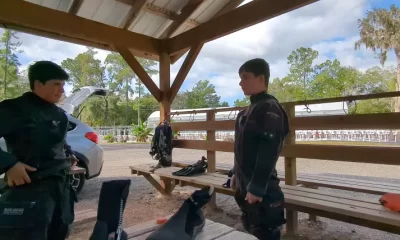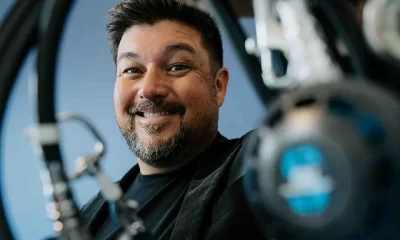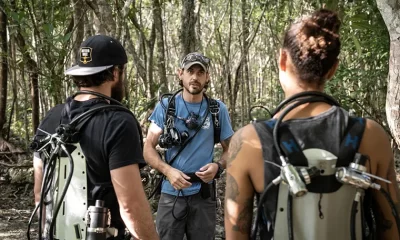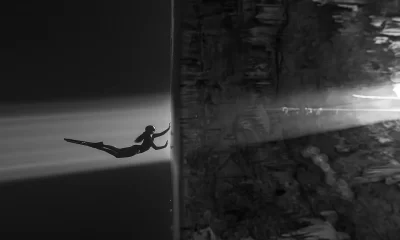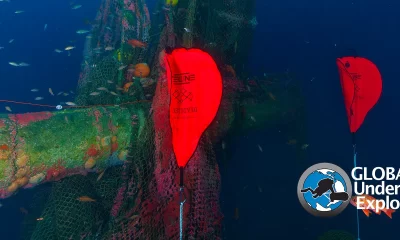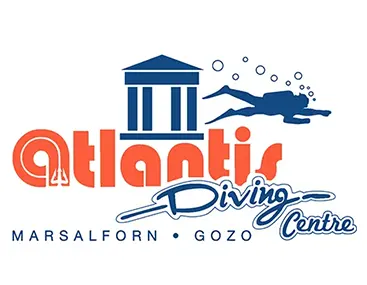Community
Brown In Bardo: Exploring the Commercial Art of Diving with Jason Brown
British photo phenom Jason Brown continues to redefine the commercial art of diving, all the while thrilling dive audiences around the planet. Where does he look for inspiration? And why is he always seen in the company of a boxer named Rufus? InDepth editor Amanda White chats up the man behind BARDOCreative in search of answers.
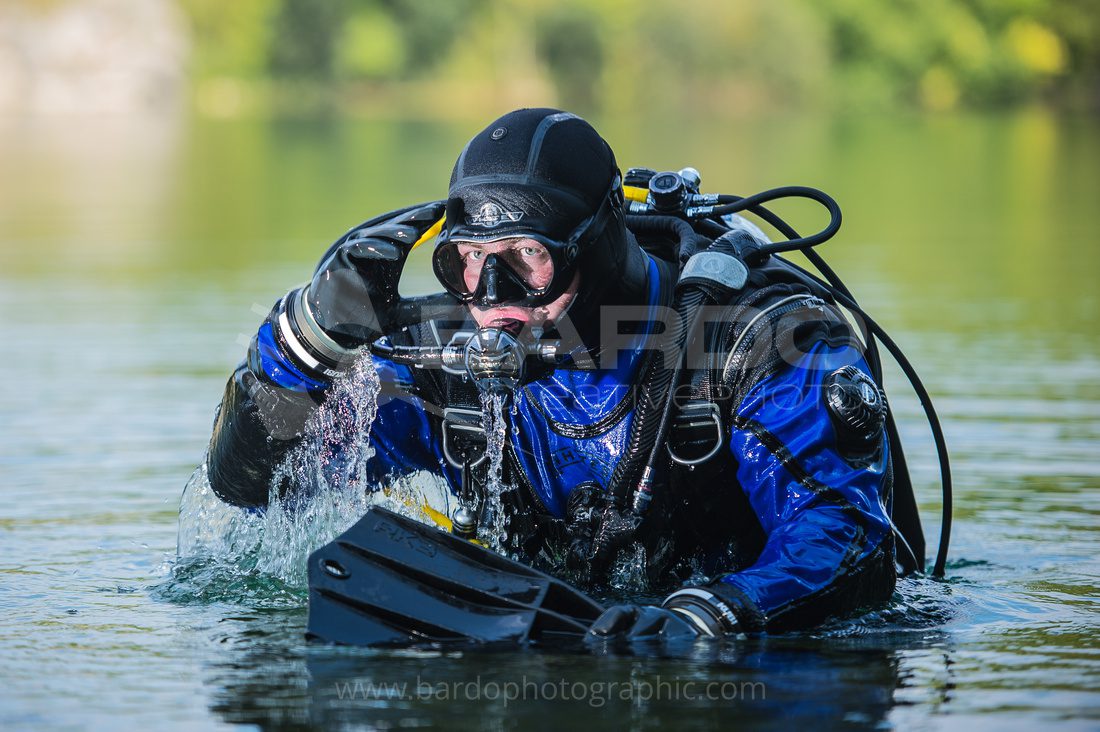
By Amanda White. All photos courtesy of Jason Brown.
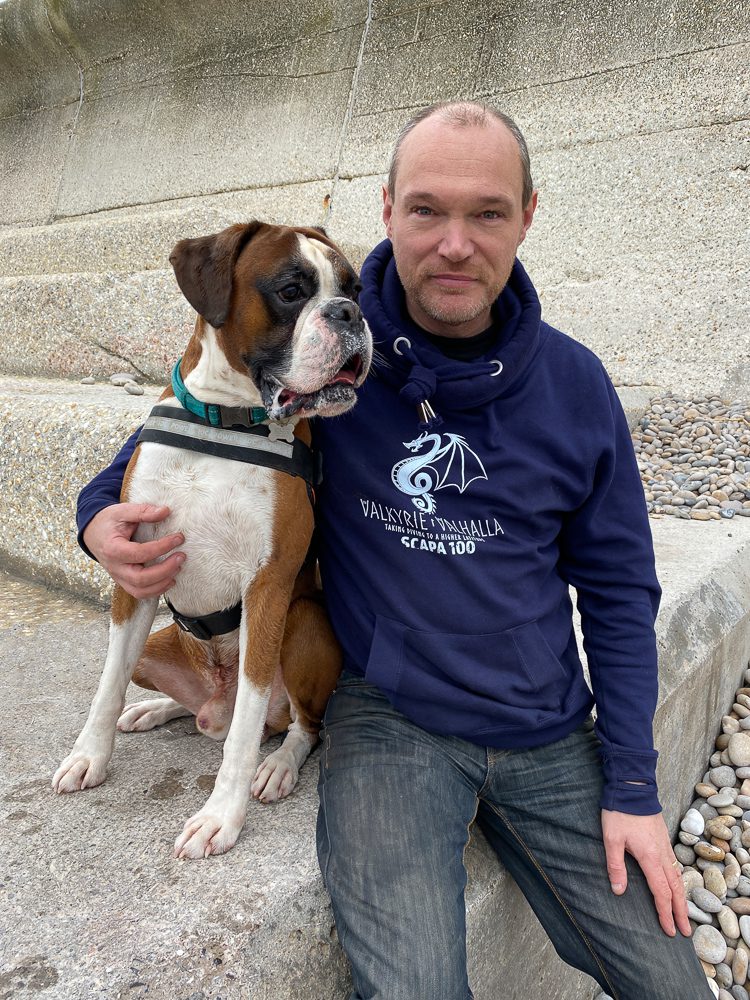
British picture maker Jason Brown has been wowing the dive industry with stunning magazine covers, striking underwater imagery, and creative commercial photography. If you haven’t heard of him or his company, BARDOCreative, he is a man of many talents, who has transported us through time and space to feel as if we are a part of his images. We recently had a chat with Jason to learn a little bit about him and his photography. Dive in!
InDepth: Please tell us a little bit about your background.
Jason Brown: As a kid growing up in the ’80s, I loved tinkering with early 8-bit computers. Like many teenagers of the time, I would spend my days glued to an old TV screen connected to a Commodore 64 in my bedroom. What really changed things for me, though, was the advent of the Commodore Amiga. The Amiga was a revelation, and programs like Deluxe Paint got me hooked on using computers for creativity. It did stuff that was just unheard of back then. You could record and remix digital sound, overlay graphics onto live video with a genlock, and even capture real-world digital images directly into the computer and manipulate them in Deluxe Paint. The Amiga practically invented digital art!
The Amiga got me my first job working in editorial for one of the biggest consumer magazine publishers in the U.K. Working on magazines was a lot of fun, as I would spend everyday rubbing shoulders with some very creative people—writers, fellow editors, designers, illustrators, and photographers. As a completely self-taught photographer, I credit those early magazine days as my best teacher.
How did your underwater journey begin?
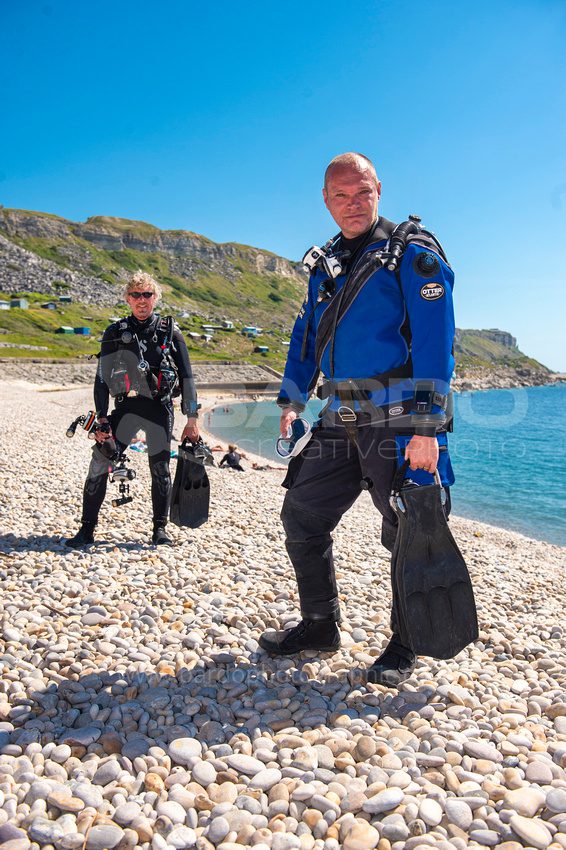
If I have one regret, it’s that I wish I’d taken up diving earlier. Like many, I was convinced to sign up when a friend was given a PADI Open Water course for his birthday. I was in my late 20s when I took my first breath of compressed air and some twenty-plus years later, I’m still loving every minute of it. Having switched to diving a twinset fairly early on, I discovered Global Underwater Explorers (GUE) and took DIR Fundamentals (as it was called back then) in 2006 with former GUE instructor Andy Kerslake. Since then I’ve climbed the GUE ladder to Tech 2 and more recently, CCR 1 with Graham Blackmore, one of the best instructors that I’ve been fortunate enough to train with. The switch to CCR has been a revelation. It’s been tough unlearning some deeply ingrained habits, but it’s been so worth it.
What was your motivation to switch to CCR?
My switch to CCR was driven by a single, very focused desire to photograph the wrecks of Malin Head off the coast of Ireland. Laying in 60 meters-plus, you can do them on open circuit, but to truly appreciate them without running up an obscene helium bill, you need to dive them on CCR. I’m sure everyone has seen photo pioneer Leigh Bishop’s images of the massive 13.5” naval guns on the wreck of HMS Audacious or the Sherman tanks stacked on top of each other on the Empire Heritage—the Malin wrecks are a photographer’s dream! Visibility of 40 meters-plus is not unheard of, so you can really capture the scale of these amazing wrecks.
You participated in project diving before your switch to CCR. Can you tell me a little bit about what projects you were involved in and your role?
One of the first projects that I was lucky enough to be involved in was based out of Portland in Dorset here in the U.K. A team of passionate volunteers set it upon themselves to scour the seabed off Portland and Weymouth looking for uncharted wrecks, many of which had never been dived before. Using sidescan data captured during longs days scanning the seabed, we’d identify marks of interest and would set out to dive them. Sometimes those marks would simply be scrap on the seabed but, with surprising frequency, we’d find stuff of genuine historical interest, too.
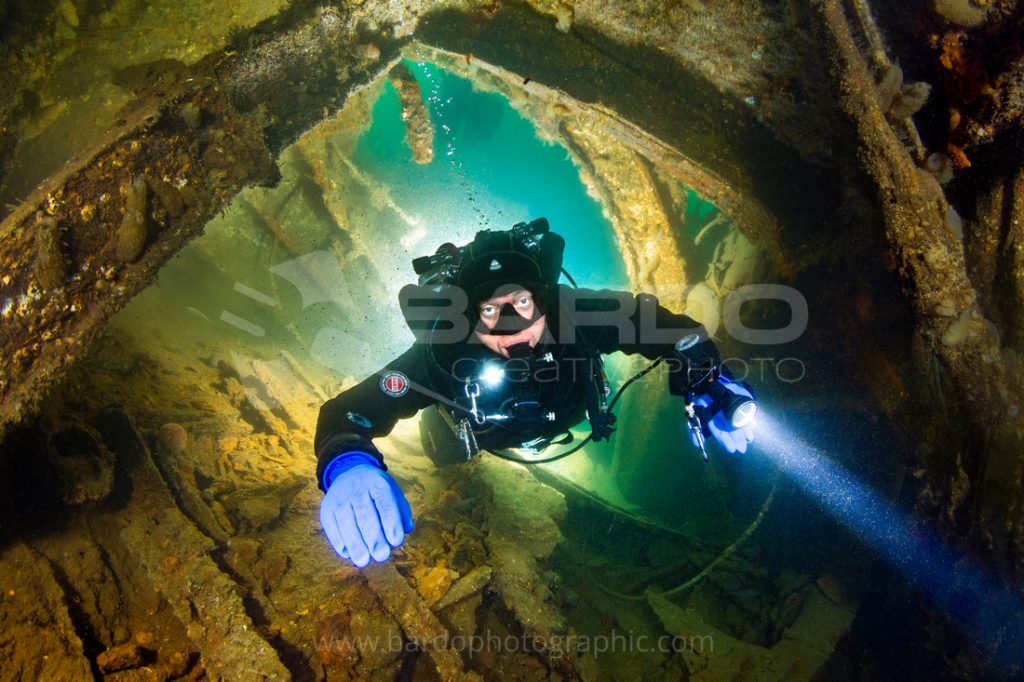
“What always surprised me was the sheer volume of objects of historical significance just waiting to be discovered.”
What always surprised me was the sheer volume of objects of historical significance just waiting to be discovered. We got to the point where finding yet another Admiralty anchor or a centuries-old cannon was considered routine! Then, of course, there were those days when we’d stumble across really exciting finds. The seabed off Portland is very dynamic—it constantly shifts, burying some objects and revealing others. For me, a real highlight was the day we located a large section of hull from a 17th century vessel that had been buried for many years. We were certainly the first people to lay eyes on her since the day she sank! It’s a bittersweet memory too as my buddy that day is no longer with us.
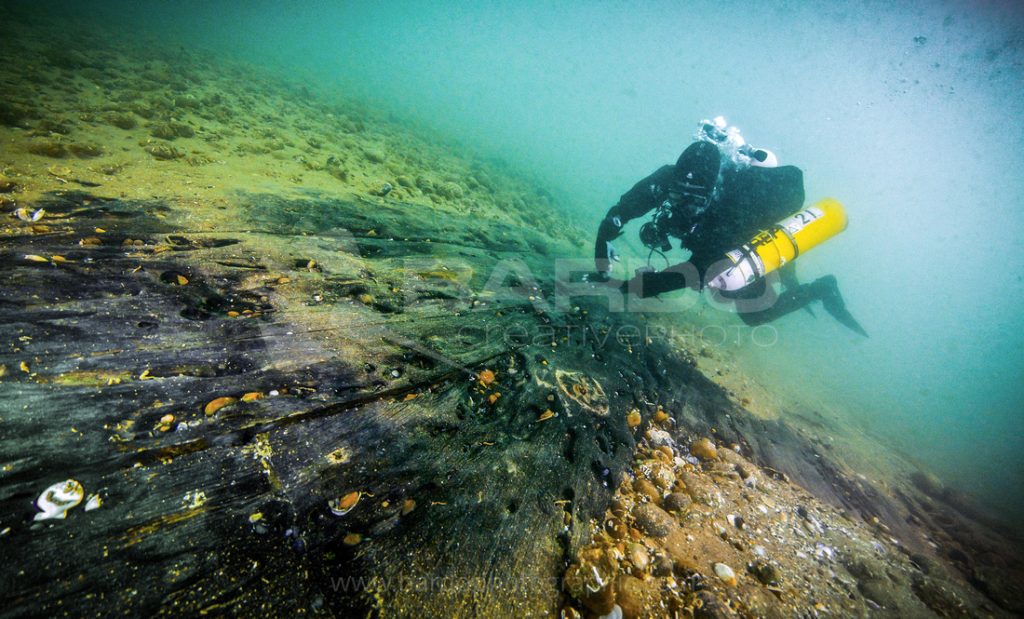
My role on that project was to record what we’d find underwater through my photography. Photography had two purposes: The first would be to aid in the identification of the objects we’d find. The second—and possibly even more important purpose—would be that my images hopefully inspire others to take an interest in maritime history. We even set up a visitor center where divers and non-divers alike could view artifacts recovered from wrecks in the local area and learn more about Portland’s rich maritime history. These days, of course, the focus has switched more to photogrammetry, but I still feel that photography has an important role to play. 3D models are a fantastic visualisation tool, but they can also be rather clinical. Photography, on the other hand, gives far greater scope for creativity.
“These days, of course, the focus has switched more to photogrammetry, but I still feel that photography has an important role to play.”
In recent years, I’ve started giving something back to the community by sponsoring a number of U.K.-based projects. I’m proud to support the amazing work that GUE Instructor Marcus Rose has been doing with Project Baseline here in the U.K. Hopefully I’ll be able to get actively involved in a few of them, too!
You have no interest in photogrammetry?
Far from it. I honestly think that photogrammetry is a very exciting development, especially for project diving. I just don’t believe that it replaces traditional photography. If anything, it supplements it very nicely. Diving explorers like Ingmar and Richard Lundgren, Immi Wallin, Chris Rowlands, and Kari Hyttinen are doing some amazing things with photogrammetry and have proven its worth as a fantastic tool for visualising wreck sites. I see photogrammetry as an additional skill set that I could bring to diving projects, rather than being a skill I can offer commercially. The key to being a useful member of any project team is to bring skills to the table that both compliment and indeed supplement what they may already have. If you have the camera gear, it makes sense not to limit what you can offer.
Tell us a bit about how you came to name your business Bardo?
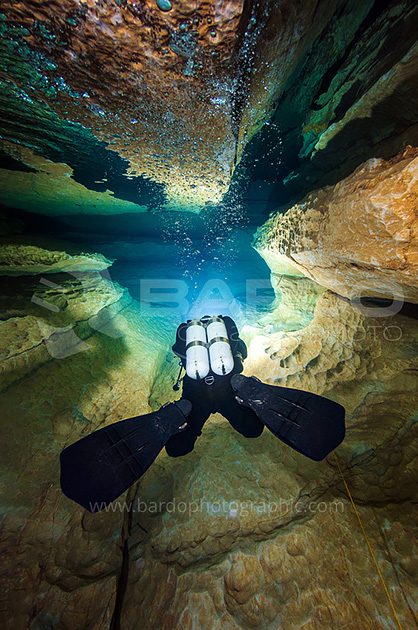
Contrary to what most seem to think, it’s got nothing to do with 1950s French actresses and a whole lot to do with my exploration of Buddhism back in my 20s. It’s actually a reference from the Bardo Thodol (or TheTibetan Book of the Dead as it’s called in the West). Wikipedia explains it better than I could as “the state of existence intermediate between two lives on earth.” The Tibetan text describes, and is intended to guide one through, the experiences that the consciousness has after death in the Bardo—the interval between death and the next rebirth. Who knew I was quite so deep, eh?
Very poetic. How did you get into photography?
My first exposure to professional photography was during my magazine publishing days. Magazines are very visual mediums and need a constant supply of professional-quality photographs, and so I would spend many long days trapped in hot and stuffy photographic studios working alongside some very talented photographers. Seeing how they shaped light always fascinated me, and it’s something that I explore a lot through my own photography.
My own passion in photography started when I inherited my father’s SLR camera. It was a pretty basic camera, but it taught me how to shoot in full manual mode. Modern digital cameras are very sophisticated, but you still need to understand basic camera theory—f/stops, ISO speed, shutter speed, and so on. This is particularly important underwater as cameras will only capture what they perceive to be a correct exposure based on top-side theory. Full manual unlocks full creativity—you can capture the image you want rather than the image that the camera thinks you want.
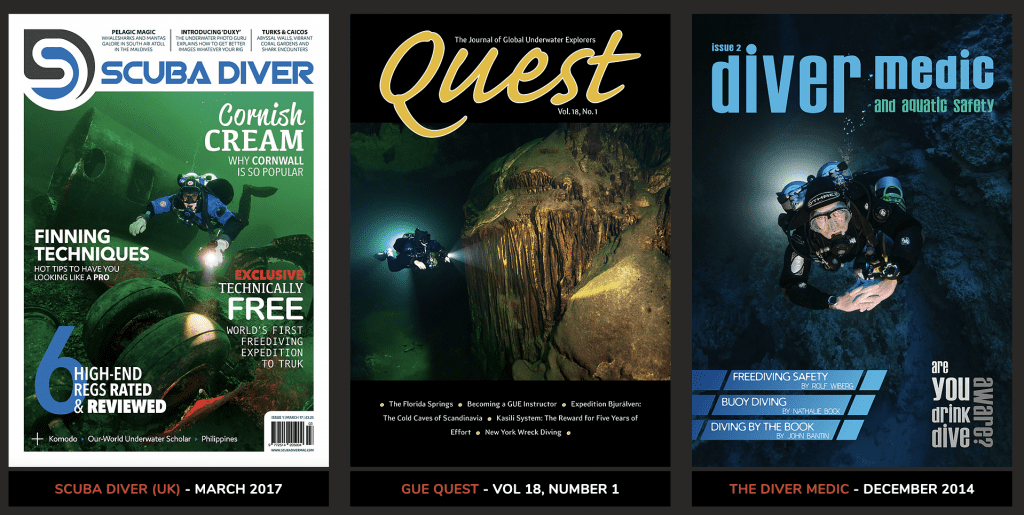
When I first learned to dive, it didn’t take long before I wanted to take a camera with me on my adventures. Back then, film was still king, so my first attempts at underwater photography were captured on a roll of 36 exposures—many of which usually ended up in the bin. Shooting film is far more challenging than digital. Compared to the technology available to photographers today, getting a decent image on film was a lot more hit-and-miss.
Do you ever still shoot with film?
I honestly haven’t shot on film for many, many years now. Very occasionally, though, I do like to set myself a challenge. I will allow myself a maximum of 24 shots and go shoot something interesting. Forcing yourself to not “spray and pray” really makes you focus (if you’ll pardon the pun) on each and every shot. That’s one aspect of film photography that I fear we’ve lost—that sense that you’ve only got a very limited opportunity to get it right. In my experience at least, restricting yourself in this way often results in far better photos
“That’s one aspect of film photography that I fear we’ve lost—that sense that you’ve only got a very limited opportunity to get it right.”
You are doing more than just capturing your time underwater, you now work with brands and magazines doing commercial photography and graphic design. How did you get into that?
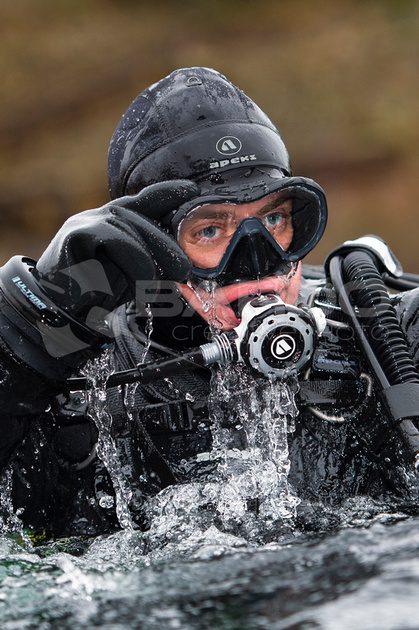
Through blood, sweat, and tears. Seriously though, none of it happened overnight, and it required a lot of networking to get my name out there and develop the contacts I have today. Ten years ago I was working in marketing for a travel company, and I would always become disheartened when days trapped in the office would stop me from going diving. In 2010 I made the decision to sack my boss and start working for myself. I really didn’t have a robust business plan; I just knew I wanted to be able to go diving whenever I wanted. Of course, the reality is somewhat different, and I still find myself occasionally trapped by work. Finding like-minded friends who can skip work to go diving is always a challenge, too, and then there are those pesky project deadlines that still get in the way. To be fair, being self-employed does give me a lot more flexibility to do what I want when I want, though. That alone makes it worthwhile.
Does anyone work with you on your projects?
For me, every shoot is a collaboration—whether it’s with your models, the client, or indeed your dive buddy. I always welcome input, and I’m always open to trying something different if I think they have a cool idea. Never assume that you’re the only one with the creative ideas.

You need to learn to collaborate when you’re working with diver models in water. As any underwater photographer will confirm, models can make or break a shoot. Diving with someone who instinctively knows how to be a good model can make the difference between capturing great images and a wasted dive. Developing that understanding takes time and doesn’t happen overnight. That said, I’m always mindful that I don’t want to monopolize my dive buddy’s in-water time. Often they’ve paid to be on the boat too, and the last thing they want is to spend the entire dive posing for my camera!
What is your thought process like when you’re doing a shoot?
It’s important to understand that every photoshoot is different. There’s no “do this, do that” formula that you can apply to ensure a successful shoot. The first step is to always talk to the client to get an understanding of what they want to get out of the shoot. Some clients have a very clear idea of what they want. The last shoot I did for Apeks, for example, was well-planned by the marketing team in Blackburn. They provided me with a comprehensive list of topside shots they needed to market and launch their then new VX-1 mask. How I executed those shots was up to me, but even then, a good photographer needs to develop an insight into the sort of “look and feel” that best matches the client’s brand. There’s no point shooting something completely off the wall if it doesn’t fit in with either the client’s brief or their own brand image. Photo commissions aren’t about you as a creative; they’re about satisfying the client’s needs.
“There’s no point shooting something completely off the wall if it doesn’t fit in with either the client’s brief or their own brand image. Photo commissions aren’t about you as a creative; they’re about satisfying the client’s needs.”
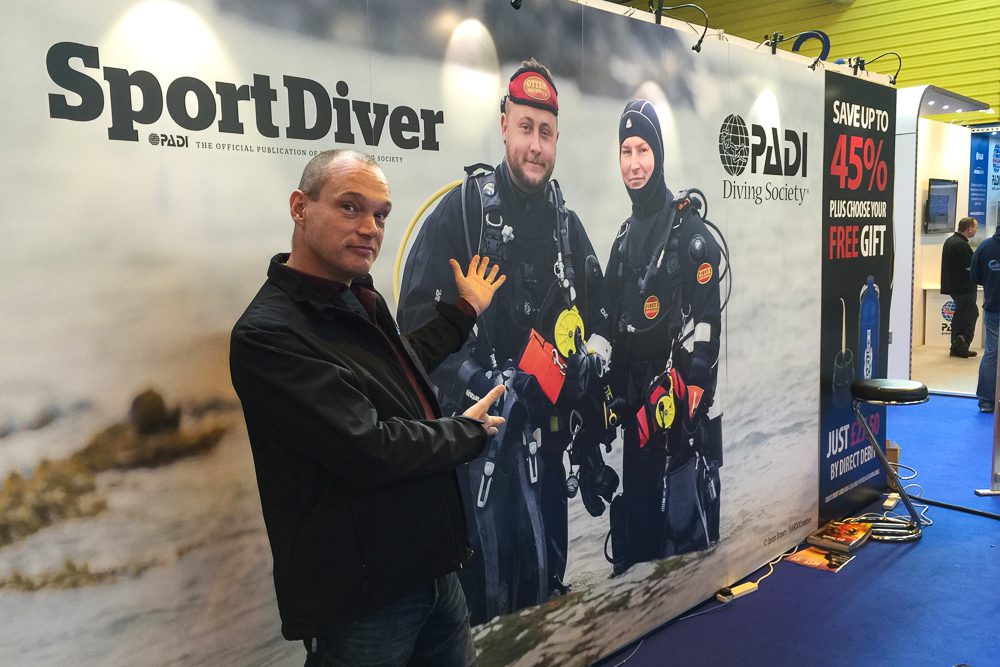
Do you have any favorite projects that you’ve worked on?
Magazine shoots are always fun, and occasionally you get to travel to some quite exciting destinations. One of my favorite trips was to the beautiful island of Alphonse in the Indian Ocean, which was sponsored by the Seychelles tourist board. Three other photojournalists from the U.K. dive press and I were whisked away to a private island catering to the rich and famous. This island was just paradise personified and would normally cost far more than I could ever afford. Being able to spend a week on the island being treated like royalty under the pretense of writing a travel feature was quite a sweet gig!
Due to HSE restrictions here in the U.K., all my paid commissions are topside only. The stuff I shoot underwater is licensed as stock photography via my website, so I get a lot more free rein over my underwater images. That said, I do tend to tailor what I shoot with an eye to future licensing opportunities.
“What I enjoy is shooting people underwater. For me, what makes an image interesting is human interaction with the underwater world.”
What I enjoy is shooting people underwater. For me, what makes an image interesting is human interaction with the underwater world. It’s that human element that subconsciously connects us to an image. Without a diver, a photo of a wreck is just a shot of a pile of rusty metal on the sea bed. Photography is story-telling, and having a diver in your shot just adds a whole different dimension that invites the viewer to ask questions about what they are seeing.
Tell us about the InnerSpace piece? What was the assignment? What was the most challenging aspect?
The InnerSpace poster was my panacea to the coronavirus lockdown. Like many self-employed people, the lockdown had a dramatic impact on my business. Virtually overnight, I found myself with zero work, as dive businesses and magazines all shuttered up and closed down for the duration. Not being the sort of person who would busy himself with gardening, I spotted a competition on Instagram being run by camera equipment manufacturer Godox inviting photographers to shoot cool and imaginative imagery at home during lockdown. It gave me the excuse I needed to get into the studio and get creative!
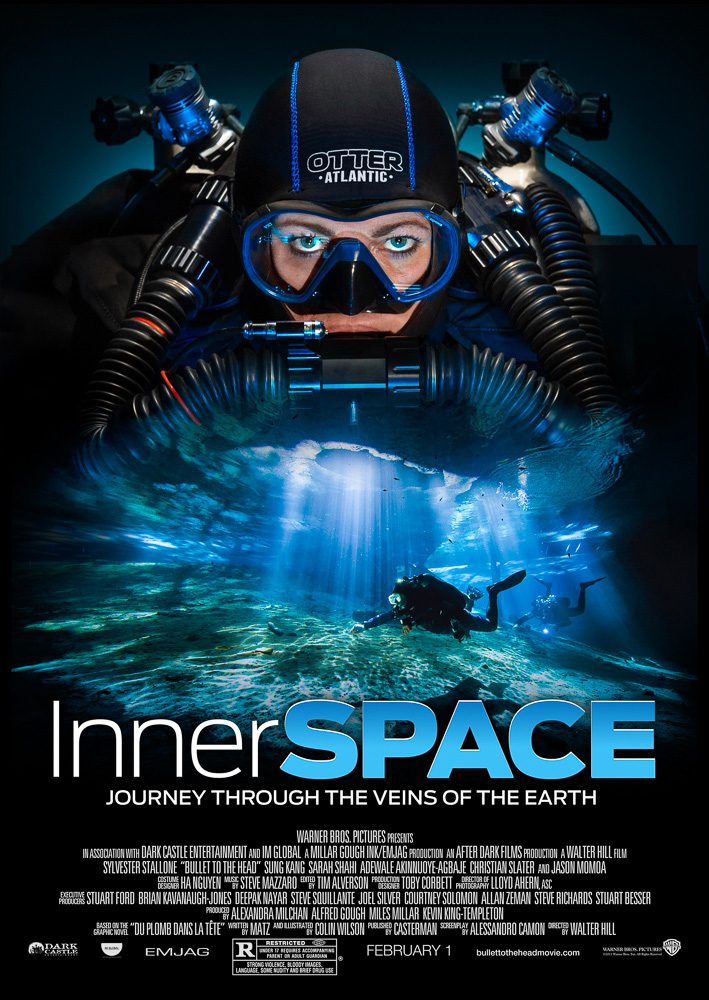
Being unable to dive my JJ-CCR due to lockdown restrictions, I decided to create a cool movie-style poster in the studio by combining a stylish sci-fi style shot of the CCR with one of my underwater shots from Dreamgate cenote in Mexico. My long-suffering wife was drafted to model. I set the unit up on a table top in the studio and sat her into it. You’ll be relieved to know that the unit wasn’t functioning and the loop was closed. She still hated every minute of it but tolerated my creative distraction without so much as a complaint. She’s definitely a keeper.
The images were then combined in Photoshop, and the fancy movie text added to complete the effect. I’m pleased to report that the movie poster image seemed to do well—Godox picked it up, and I bagged myself a nice prize. I’m pleased to report that the CCR diver image has also been picked up by Otter Drysuits for a future promotional campaign. All in all, not a bad way to turn lockdown into something positive.
I love the shot of the cave diver looking up towards the light. Can you tell me a little bit about it? What were you envisioning?
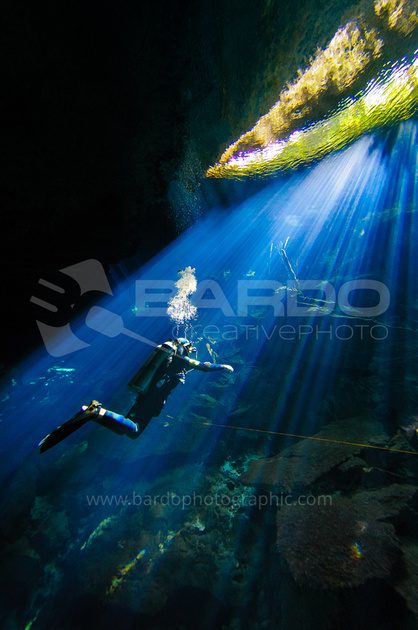
I captured that image on my first trip to Mexico back in 2013 at Chac Mool cenote—probably one of the most famous cenote dives in the area. Chac Mool is best known for the breathtaking light show that appears in the head pool for much of the day. To get the full effect, though, you need to time it just right so that the sunlight cuts through the water at just the right angle. I challenge anyone not to be blown away by the beauty of Chac Mool as the strong sunlight cuts through the clear cenote waters. As a photographer, it’s a dream come true. You cannot fail to capture amazing images in such an environment. The first time I visited Chac Mool, I don’t think I got any further than the head pool. I literally spent 90 minutes just shooting the light beams!
“As any cave diver will tell you, the stream of light that cuts through the water at the end of a cool cave dive is always a welcome sight. Even though it signals the end of the dive, we subconsciously feel drawn into the light as it signals safety and a return to the world.”
As any cave diver will tell you, the stream of light that cuts through the water at the end of a cool cave dive is always a welcome sight. Even though it signals the end of the dive, we subconsciously feel drawn into the light as it signals safety and a return to the world. My idea for the shot was to create an image of a diver literally being drawn into a welcoming beam of sunlight, drawing them toward the surface like a sci-fi movie tractor beam. Convincing my model to drop out of trim for the shot was probably the biggest challenge. As any GUE diver knows, diving out of trim just feels wrong, but once I’d explained what I wanted to achieve, he was very obliging. I’m still impressed that he got the angle so right!
None of what I capture underwater is shot for a particular client, and so it always pleases me when one of my photos is picked up by a big diving brand. That particular image was featured on a full-page advert and exhibition stand for Fourth Element. Seeing your work being used as the eye candy for a high-profile promotional campaign never gets dull.
How does it feel when you see your finished product being used at a dive show or in a magazine?
It’s always a buzz! I’ve been lucky enough to have my photography featured on quite a few magazine covers over the years, and even now it still makes me beam when I get a cover. Most magazines will tip you off when your image has been selected, and some will even send you a “strictly for your eyes only” preview of the cover layout. Getting a screenshot of a future cover in my inbox first thing in the morning always brightens my day!

The worst thing about getting a cover, though, is not being able to tell anyone for a couple of weeks. Until the issue hits the newsstands, I have to keep it to myself. Even now, I still get some of the better covers blown up to poster size and framed. These take pride of place on the wall in my office and serve as a constant reminder of some of the awesome stuff I’ve been fortunate enough to photograph over the years.
Spotting my photography at dive shows is always very cool, too. Most recently, my shot of the Bristol Beaufighter wreck in Malta was blown up and displayed on a 6 m/20 ft wide light box at the Go Diving Show in Coventry, U.K. You really couldn’t miss it!
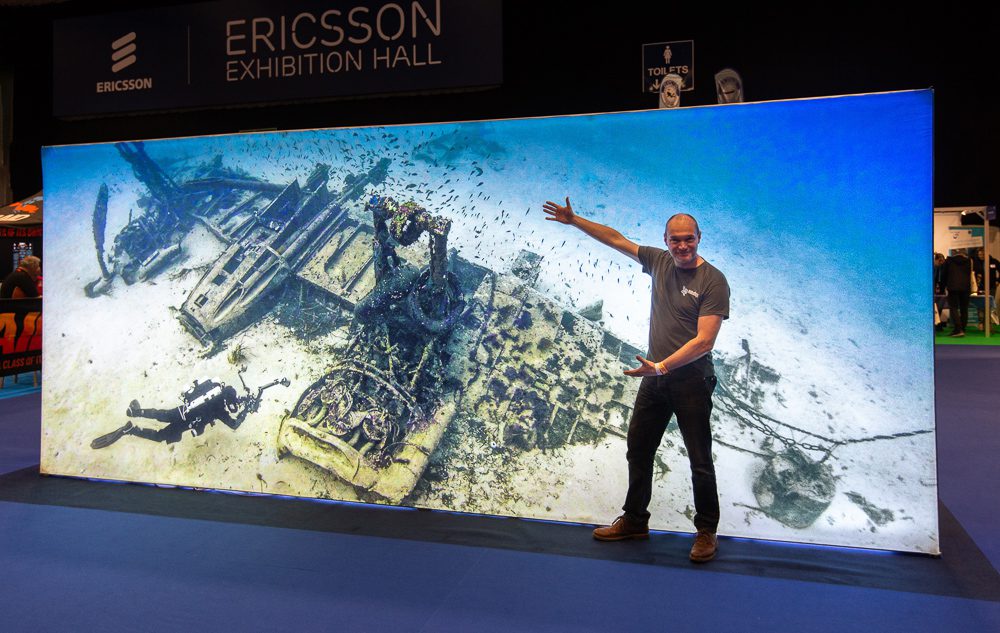
Can you tell us a little bit about the shoot for this cover of Scuba Diver magazine with a 17-year-old cave diver?
That cover accompanied a feature that I’d pitched to the magazine about young U.K. cave diver Robert Thomas. It was a perfect fit for the magazine as they were keen to promote young people coming into diving. In fact, that feature was used as the launch pad for a series of articles which ran over several months, showcasing young divers and some of the cool stuff they were doing. Most of them weren’t quite as extreme as Robert who, accompanied by his father, was squeezing himself into tight holes in the ground from a very young age.
The feature first came about when I accompanied Robert and his father on a caving trip to Porth Yr Ogof in South Wales—a beautiful cave located near the village of Ystradfellte, near the southern boundary of the Brecon Beacons National Park. I’d gone along to try my hand at dry cave photography using remote strobes dotted around the inside of the cave. During that trip, the idea of featuring Robert in the magazine had come about. I spent most of the day snapping shots for the potential feature of Robert and his father in this beautiful Welsh cave.

The one thing I didn’t have, though, was any underwater shots of Robert, so we hatched a plan to shoot some on another day. The U.K. isn’t blessed with too many caves that you can dive on a twinset, and even the cool caves like Wookey Hole are jealously guarded by the CDG (Cave Diving Group), so getting access to these wasn’t an option. Although both Robert and his father were CDG members, I was not, and CDG sadly doesn’t recognize other agency certs. To get around this problem, we travelled to Vobster Quay inland diving lake and shot some images there. If you know where to go underwater, there are quite a few little holes that, with a little creativity and some fancy lighting, you can make look like U.K. caves. So yes, I cheated. That cover shot was completely fake, but it really didn’t matter—it was an eye-catching image that grabbed the attention of anyone who picked up the magazine.
Do you do the layouts for magazine stories where your images appear? Or approve the finished product?
Magazines have their own designers, and I make a point of never interfering with their creativity. They may be my images and my words, but it’s their magazine and you have to be prepared to let go a little.
“As a photographer, it’s all too easy to get a little too attached to your own work. Different people see different things in a photo, and my opinion is no more or less valid than theirs.”
As a photographer, it’s all too easy to get a little too attached to your own work. Different people see different things in a photo, and my opinion is no more or less valid than theirs. That said, some magazines will occasionally invite your input. Scuba Diver magazine here in the U.K., for example, is really good, and I have a great relationship with both the editor and designer who makes our work look so eye-catching. If there’s a particular image that I’m really keen to have featured, they’ll normally accommodate my wish. Again, though, I don’t push it. Unless there’s a genuine reason why the image is important to the feature, I’m happy for them to choose the images that they think work best.
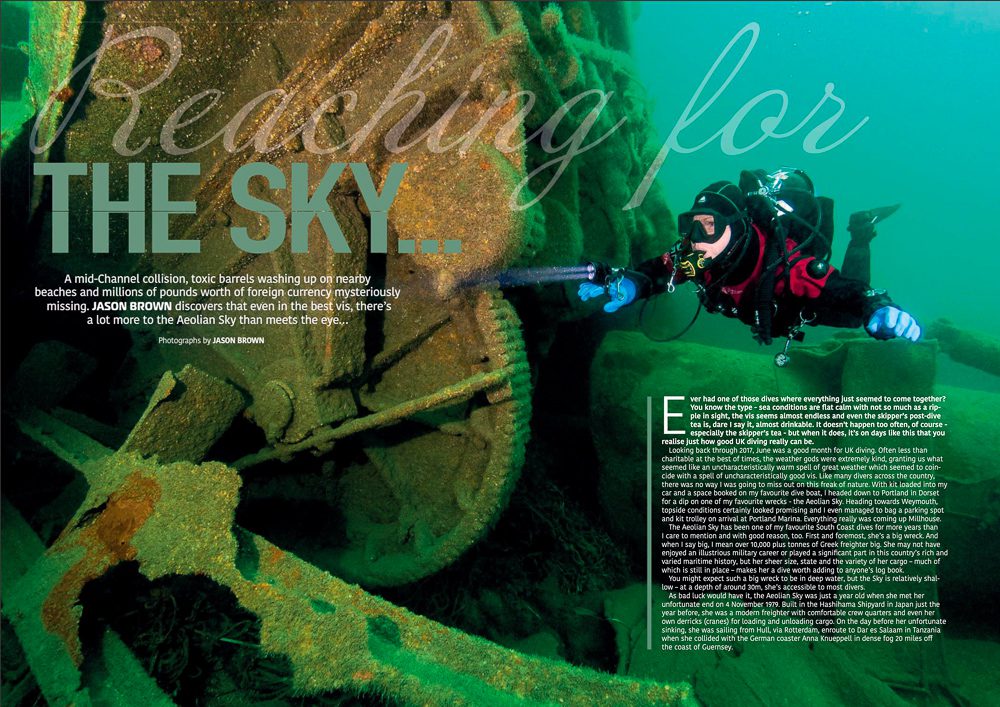
As a designer myself, I fully appreciate the pressures that magazine designers are under. The last thing they need is a precious photographer or writer asking them to make changes unless there’s a very, very good reason for it. Just let them do their job. Occasionally they’ll come up with something that doesn’t work for you but even then, it’s fascinating to see how others interpret your work.
Tell us about your work with EUROTEK and TEKCamp. What sort of challenges do you face with event photography and promotional designs?
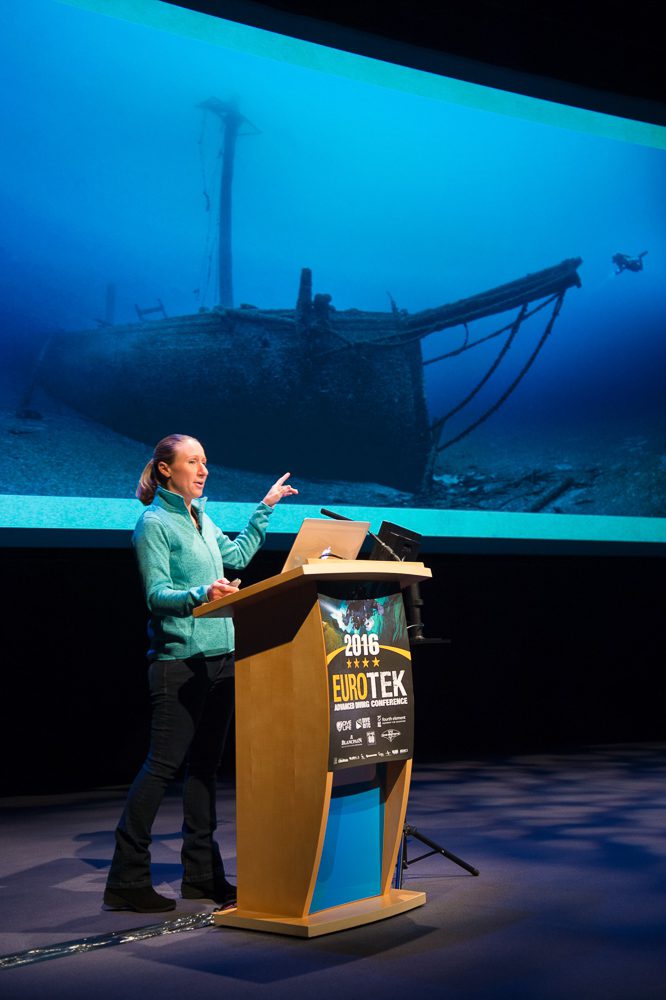
I’ve been fortunate enough to work on some superb events over the years. I’m proud to be one of the organizers of the EUROTEK Advanced Diving Conference with responsibility for every aspect of the event’s branding and visuals. I’m also the regular event photographer for the Go Diving Show and TEKCamp masterclass events here in the U.K. and have also shot both TEKDiveUSA back in 2014 and the Baltictech Conference in Poland in 2017. Each event comes with its own unique set of challenges, but they all share one thing in common—they’re utterly exhausting but a whole lot of fun!
The biggest challenge with shooting an indoor event like EUROTEK is the lighting. Using flash photography isn’t really an option, as the last thing you want to do is disturb those who have paid good money to listen to the talks. Problem is, the conference rooms tend to be very dark, so you really need to know how to capture pin-sharp photos in low light and often work with difficult mixed lighting. Using the right equipment is key here. I shoot using a Nikon D4 which offers exceptional low-light capabilities with pro-level fast lenses. You get one chance to get the shot at an event—miss it and you’re stuck. There is no way to reproduce the shot at a later date.
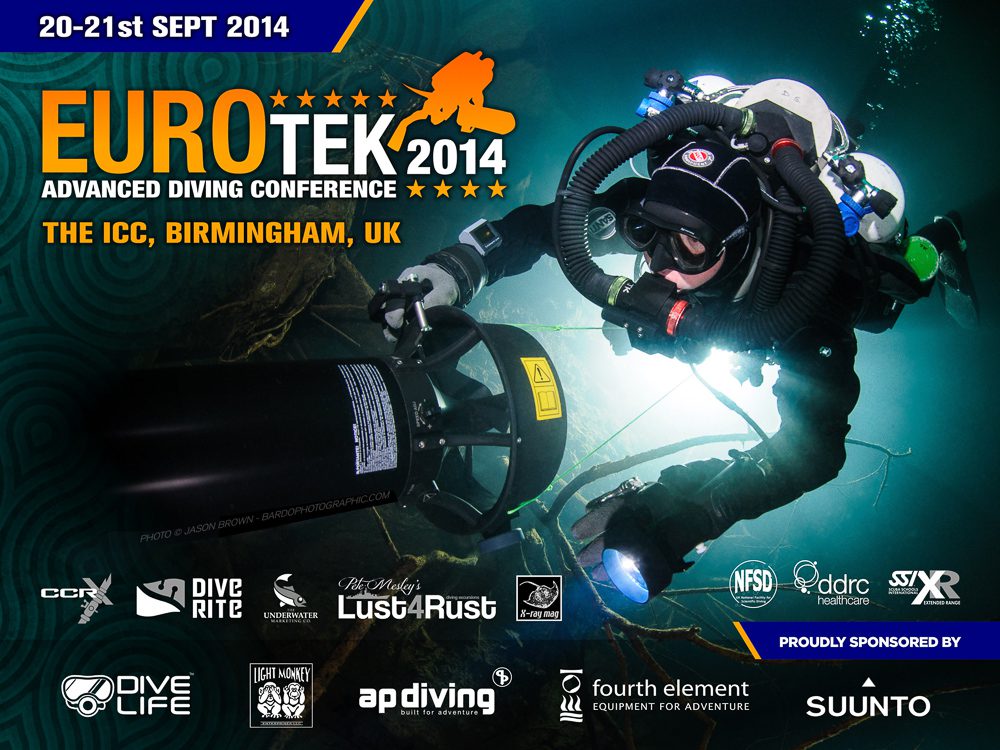
What are your plans for the future? Any upcoming projects that you are working on, or personal plans that you can share with us?
Right now, I’ll just be happy to get back into the water. The pandemic that has swept the world has left us all with serious diving withdrawal symptoms! Once restrictions are fully lifted, my first port of call will be my local diving lake to spend a few hours getting comfortable on my rebreather again. I was lucky enough to recently squeeze a couple of shallow open-circuit shore dives in for a magazine feature, but that’s been it since early March. My poor CCR has a thick layer of dust on it!
After that, who knows. I’ve got a soft spot for the caves in the Lot region of France, so a trip across the channel with my camera and as many lights as I can smuggle through the border checks is definitely on the cards for later in the year. I’ve dived Mexico a few times, but there’s something about France that I just love. I suspect the stunning food and wine have something to do with it, as does the breathtaking countryside in that part of the world. If you’ve never visited France cave country, do it—it’s truly beautiful.
Dive Deeper
Scuba Diver magazine’s Webinar: Wreck photography with Jason Brown and Becky Kagan Schott
Connect With Jason Brown:
www.facebook.com/bardocreative
www.instagram.com/bardophotographic
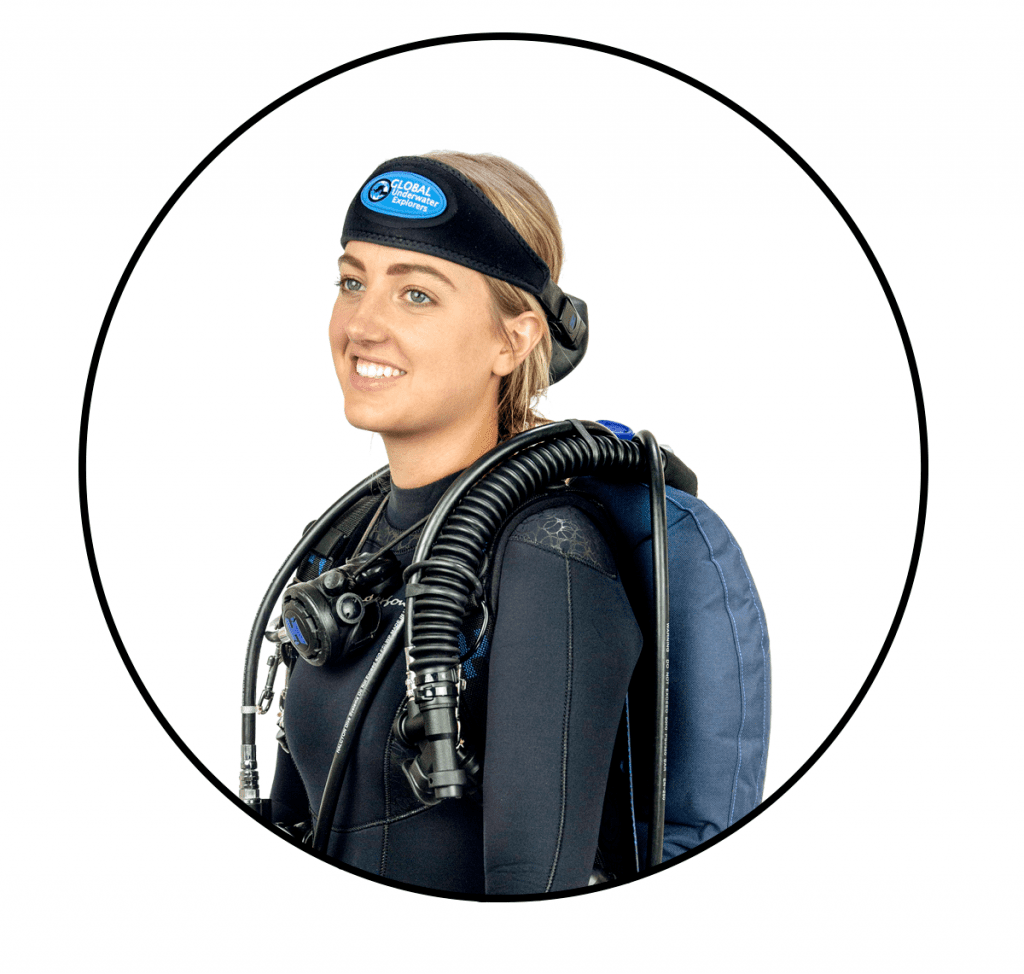
Amanda White is an editor for InDepth. Her main passion in life is protecting the environment. Whether that means working to minimize her own footprint or working on a broader scale to protect wildlife, the oceans, and other bodies of water. She received her GUE Recreational Level 1 certificate in November 2016 and is ecstatic to begin her scuba diving journey. Amanda was a volunteer for Project Baseline for over a year as the communications lead during Baseline Explorer missions. Now she manages communication between Project Baseline and the public and works as the content and marketing manager for GUE. Amanda holds a Bachelor’s degree in Journalism, with an emphasis in Strategic Communications from the University of Nevada, Reno.


















